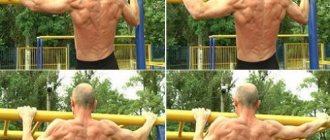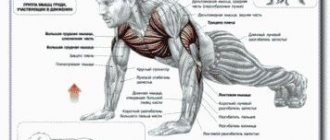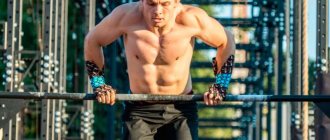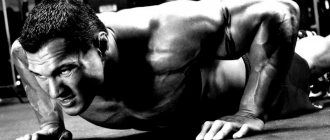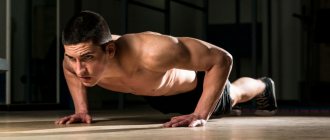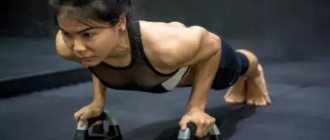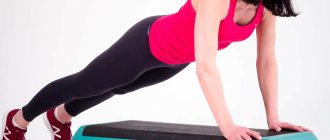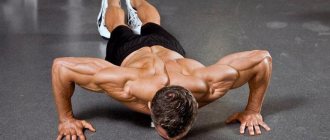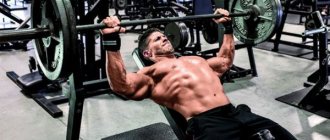Good day, dear readers. Now I will tell you about an exercise that will help you quickly build beautiful muscles in the shoulder girdle and improve your achievements when performing the bench press. Let's talk about such an important thing: how to do push-ups on parallel bars.
After all, if you stick to the technique, you will avoid sprains, and your muscles will develop faster. In addition, such activities do not require you to purchase special equipment - bars are located in stadiums, sports fields, and parks.
Pumping muscles correctly: exercises on parallel bars
Let's take a closer look at which muscles work when doing push-ups. This exercise mainly targets the triceps and pectoral muscles. The anterior deltoid muscles and the latissimus dorsi muscle are also involved in the work.
Just like when working with a barbell, you yourself can change the emphasis by doing the next exercise on the uneven bars. By adjusting the technique, you can put more stress on the shoulders, triceps or chest. The main thing here is to do the approaches correctly and feel the muscles working:
- By bending your body down, you will engage the pectoralis major muscles. By bending your knees, you will further increase the effectiveness of your workouts.
- By straightening your legs and placing your body in a vertical position, you will pump your triceps.
- Raising your elbows will put even more stress on your chest muscles.
- A narrow grip with the elbows brought as close to the body as possible will put additional stress on the triceps muscles.
The classic push-up technique involves focusing the load on the chest. Each approach, try to feel the load by slowly lowering your body. Don’t rush to do more incorrect approaches, because one technical push-up will replace four incorrect ones.
By practicing on the uneven bars, you will improve the quality of other bench press exercises. You will also improve the relief of the muscles and be able to draw their individual bundles. Exercises on parallel bars help improve posture and straighten your shoulders. To exercise, you don’t need to buy an expensive gym membership; you just need to go to the sports ground, which is located in almost every yard.
The main points of the correct technique for push-ups on parallel bars
- Learn to twist your pelvis correctly. The correct position is with your hips pulled back and your torso tilted at a 45-degree angle to your hips.
- Keep your back straight and stretch your head up. The body should be in front and above the hands, not behind.
- Don't go lower than 45 degrees at the elbows. Because this does not increase, but rather reduces the load on the working muscles.
- Don't overstretch your muscles. This does not stimulate their growth, but rather relieves tension.
- Pull the toes of your feet towards you. This stretches the hamstrings more, which helps twist the pelvis.
If you liked the article, share with your friends!
.
Schemes and burdens
Training on parallel bars can be carried out according to various schemes. You can do several repetitions using the “ladder” method. If you are training on parallel bars separately, first do a couple of sets of up to 10 repetitions, then three of 15-25 and finally a couple more sets of up to 10 repetitions. Try to rest no more than a minute between approaches, during which time you can stretch your muscles and stretch them. This will help reduce pain.
If parallel bars are just part of your workout, doing 4-5 sets of 10-15 repetitions will be enough. This will warm up your muscles and prepare them for heavier bar exercises like bench presses.
Advanced athletes should try weighted dips. To do this, you will need a special belt to hold the pancake on. When selecting weight, remember that weighted dips should begin with small additional loads, gradually increasing the weight of the pancake. Experiment with weights, select them so that you can do 6-8 repetitions in one approach.
Push-up table
There are special tables for dips, aimed at increasing the number of repetitions. Practice shows that these tables are ideal for some people, while others do not have time to progress so quickly. We recommend trying to practice using the table:
If you get stuck any week and can't complete the designated number of reps, stop there and repeat. Not everyone manages to reach the end, but you need to show perseverance. It all comes down to the time spent.
Parallel bars exercises for beginners and more
Exercises on this apparatus are not limited to simple push-ups. If you're a beginner, you might want to do one press for a while, but once you're confident doing at least 10 reps.
Dips for the pectoral muscles give good results if performed correctly:
- Exit to the uneven bars, keeping your body straight.
- Bend your arms and slowly lower yourself, trying to tilt your torso forward. There is no need to do push-ups quickly, as you will not only get less effect, but you may also get injured. Don't move by inertia, use your own muscles.
- Try to move your elbows away from your body as much as possible, placing the entire load on your chest muscles.
- During your first training sessions, hone your technique. Get down as low as possible, trying to sag so much that your hands at the lowest point are at the level of your armpits.
The workout will be more effective if the bars are slightly wider than your shoulders. If this distance is too long for you, you should exercise with caution so as not to injure your shoulder joints.
Many novice athletes want to know how to pump up their shoulders on the uneven bars. This projectile, as you already know, is more aimed at pumping up the chest and triceps. To also engage your deltoid muscles, you need special exercises with a shifted emphasis on the load.
During a regular bench press, you need to perform a special incline. As you move your body forward, move your legs back as far as possible so that your body forms a straight line.
The chest and shoulders also swing during horizontal push-ups. To perform them, you need to place your arms and legs on the parallel bars, taking a position for regular push-ups from the floor. The bars will allow you to go lower than usual, thereby increasing the load.
Additionally, you can pump up your shoulders using diagonal dips. Place your hands on the ground with your feet on the bars. Keep your body in a straight line. Slowly bend your elbows and lower yourself as low as possible. Return to starting position and repeat.
Exercises for beginners on parallel bars allow you to pump up not only the torso, but also the muscles of the lower body. You can do exercises such as straight leg raises in front of you or knee raises. They will help pump up your abs, make them strong and sculpted. It is also better to perform them slowly, without moving by inertia.
Once your abs get used to constant stress, try corner twists. To perform them, stretch your legs in front of you parallel to the floor. Hold them this way and smoothly turn your body with your legs to the sides. Try not to bend your elbows. One repetition is the movement of the legs to the right and left.
Korean dips will help load your back. To perform them, you need to stand with your back to the bar. Step out onto it so that your elbows are slightly bent and your tailbone is at the level of the bars. Smoothly lower yourself down without your feet touching the ground. Push up on your hands, returning to the starting position.
Push-up technique focusing on different muscle groups
Take a position on the uneven bars with your arms straight. It is undesirable to start push-ups from the bottom position - you will immediately give the muscles a tremendous load, instead of pumping them up gradually. Hang in this way for about a minute to prepare your body for the exercise.
To pump up the triceps brachii muscle, keep your body vertical to the floor and bend your arms 90 degrees. Elbows move along the body. We head down and breathe in the air.
You can lower yourself slowly and rise quickly - this will help develop your muscles faster, making them more prominent and voluminous. Or enter the bottom position quickly and slowly return to the top position. This approach will increase the strength of your muscles.
We rise up and exhale. The arms are fully straightened. Constantly increase the number of approaches. If you don’t yet have experience doing parallel bars, don’t overdo it, evaluate your capabilities and perform an average number of push-ups. Try to reduce the rest time between sets each week.
If you want to focus on the chest area, you should do it a little differently. Take a position at the top, lean forward slightly (this will create pressure on the pectoral muscles) and lower yourself. Raise your elbows slightly to the sides. The arms form a 30 degree angle at the lowest point.
Try to go as low as possible without causing pain or excessive strain. You can linger at the bottom for a couple of seconds - this helps to better stretch the pectoral muscles.
After training, you need to do a cool-down - stretch the worked muscles. At the same time, the fascial tissue is stretched, and the muscles will have room to develop.
After strength training, fuel up with a high-protein meal or protein shake, dried fruit or a banana. Nutrients are needed to regenerate the body and increase muscle mass.
You can find a step-by-step photo of push-ups focusing on the chest area and triceps. You will see how the body position differs in the first and second cases.
Bars for girls
Exercises on parallel bars for girls differ from men's only in the number of repetitions. Representatives of the fair half of humanity can perform all the usual exercises such as bench presses or leg raises.
Many girls start working out in order to pump up their pectoral muscles and tighten their arms. The fact is that parallel bars really help to maintain a beautiful breast shape for a long time and lose excess fat from your arms.
Girls should perform the parallel bars press with extreme caution. The correct technique will help you avoid sprains. Don't snatch even if you can't do one rep. Ask any man to help you by supporting you at the waist. Over time, you will do several approaches yourself. The main thing is not to rush, progress will not keep you waiting.
If you decide that it's time to get in shape, then dips are exactly what you need. Having selected a suitable set of exercises on the uneven bars, perform it systematically. Record your successes, make a table where you indicate the number of approaches and repetitions. Even if you initially fall behind the performance of your chosen program, do not despair. Exercise until you have completed all the necessary approaches in one session, then feel free to move forward, increasing the load.
Even with time, you shouldn’t look for something to replace parallel bars exercises with.
For even greater effect, you can go to the gym, but even there, training on this apparatus is part of many programs, because they are truly effective. Download WordPress Themes FreeDownload WordPress Themes FreeDownload Best WordPress Themes Free Downloadfree download udemy course
Briefly about the training program on the horizontal bar and uneven bars
| the main objective | Muscle building |
| Type of workout | Training for one muscle group |
| Level of training | Elementary |
| Periodicity | 4 times a week |
| Necessary equipment | Own weight, other |
| Gender | Men/women |
Program description
What do you say to the fact that there are two simple exercises that can literally transform your upper body? Interesting, isn't it? Even more surprising is that these exercises have been known for a very long time, but many do not take them seriously.
Maybe my words sound a little pompous, but this is the honest truth. Is it possible to pump up on the horizontal bar and uneven bars? Pull-ups and push-ups are the key elements of a program for building muscle mass in the upper body.
The Myth of Wide-Grip Dips
Well, now let's start destroying the myths. Are wide-grip dips a good chest exercise? The main function of the pectoral muscles is horizontal adduction. In other words, bringing the humerus (upper arm) to a conventional line running in the middle of the front surface of the body.
If you look at push-ups on parallel bars with a wide grip from the point of view of biomechanics, you can see that due to the hands being fixed in a stationary position, horizontal adduction is observed only in a small area of the amplitude.
Yes, the pectoral muscles are loaded to some extent, but since the movement is mainly shoulder flexion and elbow extension, the front deltoids and triceps actually do most of the work.
In addition, the load vector in this exercise does not pass through the chest at all. Regardless of what position your body is in during dips, the load vector passes through the front deltoids, which further contributes to the activation of these muscles.
In addition to all of the above, dips are also one of the most dangerous exercises in terms of injury.
While this doesn't say anything about its actual effectiveness for building chest muscles, it is certainly an important factor to take into account.
During dips, both the humerus rotates inward and the shoulder blades spread, which places the shoulder joints in an awkward position that can lead to injury.
Weighted dips done for long enough will definitely make you pay for the abuse on your shoulders. And believe me, a shoulder injury is one of the worst things that can happen to a bodybuilder.
So, wide-grip dips primarily target the anterior deltoids and triceps rather than the pecs, increasing the risk of shoulder injury.
Of course, you can say that you have been doing this exercise for many years, have excellently developed chest muscles and do not have any injuries. However!
- First, it's very unlikely that dips are the only exercise you do in your chest workouts. Surely you also do various presses and raises. So, there is no reason to believe that you built your pecs precisely thanks to push-ups.
- Secondly, it is obvious that not everyone who performs dips gets injured. They just increase the chances of getting it.
- Third, we don't disagree that dips can help you build impressive pecs. We are simply saying that this is the least effective exercise available.
Let's sum it up
Dumbbell and barbell presses are more effective at stimulating chest muscle hypertrophy and are safer for the shoulder joints. In terms of chest development, wide-grip dips won't do anything for you that you couldn't get from doing dumbbell and barbell presses at different angles. All they do is less stimulation of the chest and an increased risk of shoulder injury.
For this reason, there is no good reason to include dips in your chest exercise routine. For the full development of the pectorals, 1-2 bench press exercises with free weights in combination with some kind of hand pinch in the simulator are enough.
If you still want to keep wide-grip dips in your training program, it's up to you. But at least make them the last exercise in the set. Otherwise, you'll just tire out your front deltoids and triceps when they could use more freshness to perform the more important movements.
Also, use moderation in your weight selection and make sure you can control the tempo of your reps and maintain perfect technique.
tolmach15
...And maximum load for advanced
Those whose muscles no longer respond to regular workouts with a pleasant, aching pain that proves that you gave it your all, should choose a more complicated dip routine.
- Negative repetition. Its essence lies in the fact that you perform half the exercise: smoothly, lower yourself down from the starting position, and then return to the starting position, using the support of your legs.
- Forced set. Perform 5 sets of 5 reps with your usual weights. Reduce it, perform 5 more approaches. And finally the final 5 - with minimal weight. And note, there is no rest in a forced set!
- Partial set. And again, “half-hearted” exercises, which consist in the fact that you do not reach the end in any direction. At first, you lower yourself only to half the possible depth, and then when you rise, you do not fully extend your arms.
Important! For beginners, forced and partial sets are dangerous, so don't try to do them yourself. Damage joints and ligaments.
Tips for beginners...
What if your triceps are still in their infancy and are not able to lift body weight? How to replace dips?
- Do push-ups with a narrow and wide grip.
- Perform bent-over dumbbell swings.
- Do the bench press on a reverse incline bench (head down).
- Once you reach the bars, perform partial push-ups without lowering your body down to the limit.
- Use a graviton (gravitron) with partial knee support. Or with the help of a partner.
Great help for beginners
Execution technique
Acceptance of the starting position
The exercise is performed in support on the uneven bars. To accept it, you must:
- take the parallel bars with a medium grip, palms facing each other;
- by lightly jumping with your legs, take a standing position;
- move your shoulders away from your ears, relax your trapezius;
- place the body vertically so that it stands stably in the bars
The starting position can also be taken from a stand if the projectile is high and it is not possible to jump into a standing position without overloading the shoulder joints. Push-ups in the gym are performed on standard racks that have foot rests. If the exercise is done with a weight attached to the belt, it is advisable not to take the starting position on the uneven bars with a jump, so as not to injure your shoulders.
Movement
Lowering the body occurs with inhalation. You need to inhale slowly and lower your body under control in one movement, elbows bent together. Exhalation occurs with effort. Having lowered your body until your forearm is parallel to the floor, you should exhale sharply and, as it were, “squeeze” your body up. Next, the entire planned series of push-ups is performed, and the athlete places his feet on the supports of the parallel bars and carefully returns to the starting position
During movement, you need to focus on the work of the triceps
Attention
A technical mistake is to slouch your shoulders forward and perform the exercise with a round back. This is dangerous because when you slouch, the shoulder joints are overloaded, and the person risks injuring the ligaments.
There is no need to “insert” your elbows as on a competitive bench press, this overloads the elbow joints and when performing other high-repetition work on the elbows (presses in machines, with a barbell and with dumbbells), it can lead to injury;
“Throwing” the body down is also a mistake and can lead to injury. In addition, the lack of control during the lowering phase does not allow the athlete to effectively work out the muscles.
Raising the elbows to the sides in the triceps version of the press is not allowed, since the athlete thus shifts the load on the pectoral muscles.
Recommendations
Preliminary joint warm-up and light stretching of the triceps, anterior shoulder and biceps are mandatory; Each athlete must find an adequate depth of descent for himself, comfortable for the shoulder joint, and anthropometrically convenient
Push-ups that are too deep can lead to hyperextension of the ligaments. You can consciously press your elbows to your sides, this will remove excess stress from the muscles of the shoulders and chest, and shift the work to the triceps. It is important to stop at the bottom, contract the muscles, and avoid inertia in the movement in order to get more targeted work; Straightening your legs will help avoid swaying and excessive leaning forward. With your knees bent, it is easier to perform the “chest” rather than the triceps version of this exercise.
httpv://www.youtube.com/watch?v=embed/MEr06Tdg4LI
What do dips give you? How to do push-ups
For both beginners and experienced athletes, a warm-up is necessary before training.
Pay special attention to warming up the shoulder girdle. The better the muscles are warmed up and stretched, the lower the risk of injury.
Start the exercise ONLY from the top point. Do not start climbing from the bottom point - this is very risky, because... the muscles are stretched and the body is relaxed. Starting from the top point, the muscles are contracted, tense and ready to work.
Starting position - movement starts from the top point
Select the width of your grip and firmly grasp the bars with your hands. The grip is straight, palms facing the body. Press your chin to your chest. Shift your weight from your feet to your hands. Cross your legs and roll your shoulders back.
Inhale and begin to lower slowly. The slower you lower, the more effectively and safely you will load your muscles. Descend to a depth that is comfortable for you. Bring your shoulder blades together. Don't slouch. Don't let your shoulders move up and down or back and forth.
Lowest point when doing dips
With each workout, the flexibility of the pectoral muscles and shoulder region improves, so each time try to go deeper, but to a comfortable point. Your task is to master the full amplitude, while at the bottom point the angle at the elbow is 90° or less (the position of the shoulders is at the level of the elbows or below).
You can linger slightly at the bottom point, feeling the stretching of the muscles, but there should be no relaxation, and then begin to rise powerfully as you exhale, but very smoothly and without jerking. The descent is slow, the ascent is fast, but at the same time smooth.
While lifting, do not try to raise your head or rotate it. This can cause injury. Do not allow your body to sway, control your torso position. To achieve this stabilization, strain your abdominal and buttock muscles as hard as you can, while working only with the strength of your arms.
The bars themselves can be completely parallel or V-shaped. For the comprehensive development of the shoulder girdle and increasing the strength of the working muscles, shift the emphasis to the chest or triceps. Work in one style for a while, then change your focus.
Execution technique
The technique of parallel bar push-ups in a training program depends on what muscles a person intends to work. Descriptions of the exercises are given in the table:
| Exercise | Instructions | Peculiarities |
| For triceps | The distance between the bars should be greater than the width of the shoulders. The starting position is a vertical position of the body and straightened arms at the elbow joints. The elbows are pulled back. As you inhale, you need to lower yourself down as far as the elasticity of your shoulder joints allows. In this case, the angle in the fold should be equal to a right angle. When performing a fitness move, the arms are pressed as close to the body as possible. As you exhale, you need to straighten your arms and rise up. | If a person has never practiced on uneven bars before, then to ease the load, the elbow joints are extended during the peak. Advanced athletes are advised to maintain a slight angle at the elbow joints to maintain a high load on the triceps. |
| On the chest muscles | The distance between the bars should be almost the same as the width of the shoulders. After jumping onto the apparatus, you need to spread your elbows to the sides. In this case, the body must be tilted at an angle of 30 degrees. As you inhale, you need to lower your torso down, while spreading your elbows to the sides. This movement should not cause muscle discomfort. Stretching should be felt in the chest area. As you exhale, contract the pectoral muscles to raise the body to the starting position. At the peak point, the shoulder blades should be brought together as closely as possible, and this position must be maintained for several seconds. | Bodybuilding and fitness experts recommend performing this fitness move after performing a bench press designed to pump up the sternum. |
| For quadriceps | Take the classic starting position, but at the same time it is necessary to bend the knee joints so that they form a right angle. The legs should be pulled up to the stomach as much as possible. In this position, it is necessary to perform pull-ups in the same way as the triceps exercise. | This fitness routine is more suitable for advanced athletes. |
Reverse grip dips
This is a difficult technique that should only be attempted once the lifter can perform 4-5 sets with perfect form without weight. This option puts a lot of stress on the triceps, and also involves the forearms to a greater extent (than with regular push-ups).
Features of execution:
- The general technique does not change, except for the position of the hands (reverse or pronated grip).
- It is recommended to avoid full range of motion initially to minimize injury. Start with partial range of motion, gradually increasing the extension of the arm at the elbow.
- Do not lean your body forward. Try to perform the movement so that your body remains upright.
Subtleties of training
On paper, everything looks simple - jump up, do push-ups. But once you get down to business, you will immediately have a lot of questions, from the width of the bars to where to put your elbows.
Before you reach aerobatics, you have to master the basics
- First of all, watch your body position. Do you want to increase the load on your pectoral muscles? Lean your body forward more. For triceps? Take an almost vertical position. The key word here is “almost”! By staying in a strict vertical position, you will sooner or later injure your shoulder ligaments.
- You can force the pectoral muscles to work in another way, simply by spreading your elbows to the sides. If you try to keep them as close to the body as possible, the triceps will have to pull the main load.
- A complete parallel bar push-up program must include exercises with implements of different widths. The farther the bars are placed from each other, the more the pectoral muscles and pectoral deltoids will have to be involved in the work. The narrower it is, the better you will work your shoulders. Well, for beginners it’s better to choose the middle position - this way you won’t have to push yourself to the limit, and the risk of injury will be reduced.
Efficiency Tips
- For beginners, it is not so much the weight of the weight in push-ups that is important, but the correct passage of the eccentric phase. You shouldn’t go through it with a “jump” and “squeeze” the body out of the dead center. You need to move carefully so that the muscles feel the load, and not just determine the trajectory of movement
- If you can’t complete an approach without compensation, this is not a reason to refuse the exercise. Girls, complete beginners, and those who, for some reason, cannot move with good amplitude, must compensate for part of their body weight using rubber shock absorbers, or the “gravitron” system. If elastic bands are used, they must be secured to the bars so that you can rest with straightened legs so that the trajectory of movement is not disturbed.
- Simply directing your gaze upward helps keep your body upright. If your eyes are down and your head is tilted, it is easier to do the “chest” version of the exercise.
- You can pump up your triceps quite well if you take a short pause at the point of maximum muscle contraction and statically contract them at the top of the range of motion.
httpv://www.youtube.com/watch?v=embed/q-8bWppi3oU
Risks
In addition to the muscles, the training will involve the ligaments of the shoulder joints, which are easy to damage if you are a beginner or too hasty athlete. That's why…
- Firstly, do not do the exercise “from below”, trying to pull yourself up on the bars - this is a big mistake. Push-ups begin from the top point, jumping onto the bars and placing emphasis on straightened arms.
- Secondly, try to keep the body as stable as possible. The grip is straight, the shoulders are pulled back and virtually motionless, the chin is pressed to the chest.
- Thirdly, do not even think about approaching the apparatus with any, even the slightest, injuries to your shoulder, elbow or wrist. All joints must be in excellent shape! For the same reason, there is no need to start training virtually from scratch, tearing your veins, trying to catch up with the professionals in the shortest possible time. Below you will find a simple and effective training scheme that will tell you how to increase the number of dips on the uneven bars without harm to your health.
Never start training without properly warming up your shoulder girdle.

